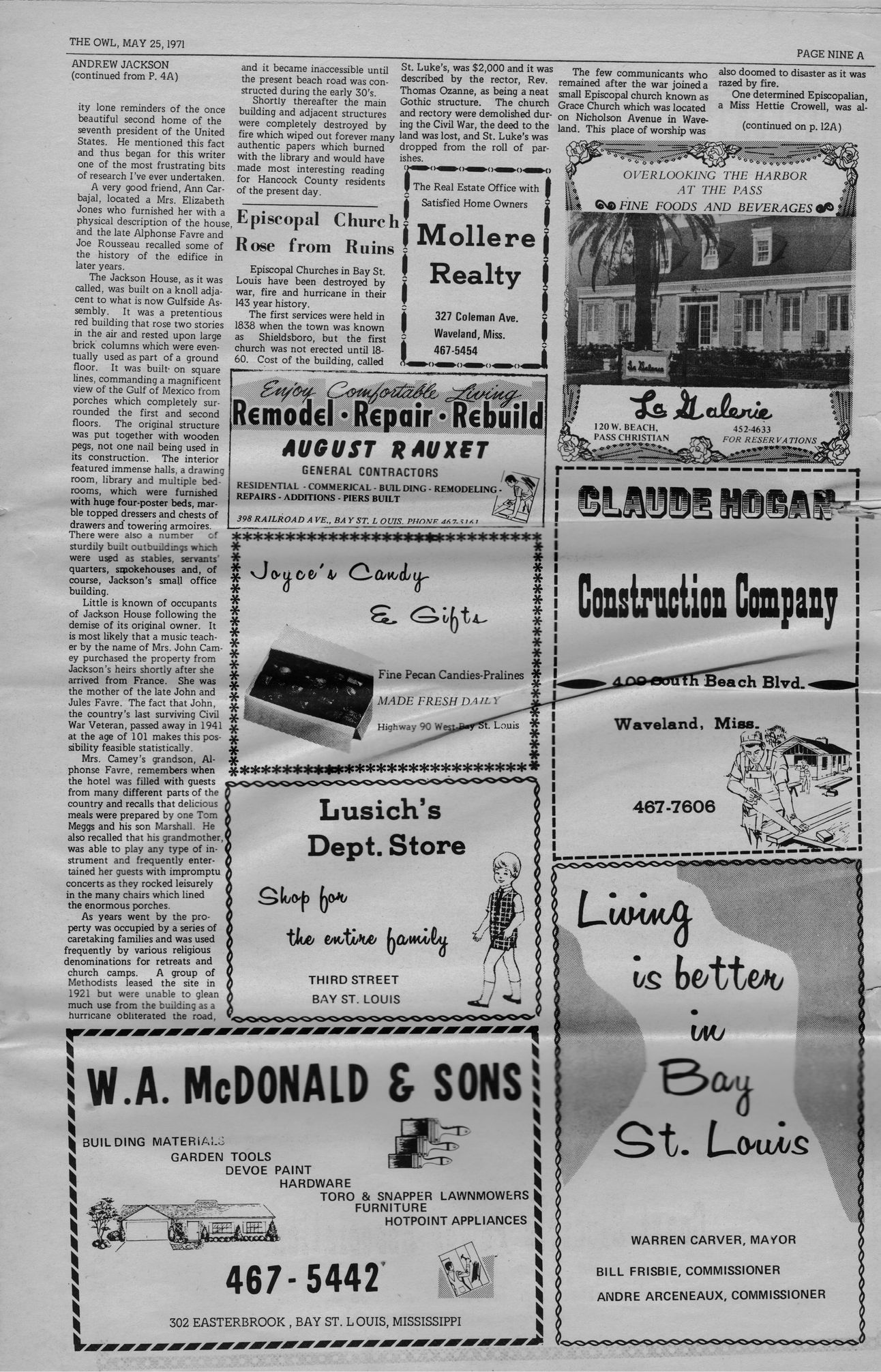This text was obtained via automated optical character recognition.
It has not been edited and may therefore contain several errors.
THE OWL, MAY 25,1971 PAGE NINE A ANDREW JACKSON (continued from P. 4A) ity lone reminders of the once beautiful second home of the seventh president of the United States. He mentioned this fact and thus began for this writer one of the most frustrating bits of research I’ve ever undertaken. A very good friend, Ann Carbajal, located a Mrs. Elizabeth Jones who furnished her with a physical description of the house and the late Alphonse Favre and Joe Rousseau recalled some of the history of the edifice in later years. The Jackson House, as it was called, was built on a knoll adjacent to what is now Gulfside Assembly. It was a pretentious red building that rose two stories in the air and rested upon large brick columns which were eventually used as part of a ground floor. It was built- on square lines, commanding a magnificent view of the Gulf of Mexico from porches which completely surrounded the first and second floors. The original structure was put together with wooden pegs, not one nail being used in its construction. The interior featured immense halls, a drawing room, library and multiple bedrooms, which were furnished with huge four-poster beds, marble topped dressers and chests of drawers and' towering armoires. There were also a number of sturdily built outbuildings whxh were uspd as stables, servants' quarters, smokehouses and, of course, Jackson’s small office building. Little is known of occupants of Jackson House following the demise of its original owner. It is most likely that a music teacher by the name of Mrs. John Carney purchased the property from Jackson’s heirs shortly after she arrived from France. She was the mother of the late John and Jules Favre. The fact that John, the country's last surviving Civil War Veteran, passed away in 1941 at the age of 101 makes this possibility feasible statistically. Mrs. Carney's grandson, Alphonse Favre, remembers when the hotel was filled with guests from many different parts of the country and recalls that delicious meals were prepared by one Tom Meggs and his son Marshall. He also recalled that his grandmother, was able to play any type of instrument and frequently entertained her guests with impromptu concerts as they rocked leisurely in the many chairs which lined the enormous porches. As years went by the property was occupied by a series of caretaking families and was used frequently by various religious denominations for retreats and church camps. A group of Methodists leased the site in 1921 but were unable to glean much use from the building as a hurricane obliterated the road, and it became inaccessible until the present beach road was constructed during the early 30’s. Shortly thereafter the main building and adjacent structures were completely destroyed by St. Luke’s, was $2,000 and it was described by the rector, Rev. Thomas Ozanne, as being a neat Gothic structure. The church and rectory were demolished during the Civil War, the deed to the fire which wiped out forever many lanc* was lost, and St. Luke’s was authentic papers which burned with the library and would have made most interesting reading for Hancock County residents of the present day. The few communicants who 3150 doomed to disaster as it was remained after the war joined a razed by fire, small Episcopal church known as One determined Episcopalian, Grace Church which was located a Miss Hettie Crowell, was al-on Nicholson Avenue in Waveland. This place of worship was (continued on p. 12A) dropped from the roll of parishes. Episcopal Church Rose from Ruins Episcopal Churches in Bay St. Louis have been destroyed by war, fire and hurricane in their 143 year history. The first services were held in 1838 when the town was known as Shieldsboro, but the first church was not erected until I860. Cost of the building, called n: i Real Estate Office with Satisfied Home Owners | Mollere j | Realty j | 327 Coleman Ave. 5 Waveland, Miss. | 467-5454 f f Remodel • Repair •Rebuild AUGUST RAUXET GENERAL CONTRACTORS t RESIDENTIAL - COMMERJCAL - BU1L DING - REMODELING -REPAIRS - ADDITIONS - PIERS BUILT 398 RAILROAD A VE., BA Y ST. L OUIS. PHDNF ; BUIL DING MATERIALS GARDEN TOOLS DEVOE PAINT HARDWARE W.A. McDONALD S SONS; TORO & SNAPPER LAWNMOWLRS b FURNITURE ^ 467-5442 302 EASTERBROOK , BAY ST. LOUIS, MISSISSIPPI

Hancock County 2 The-Owl-5-25-1971-(009)